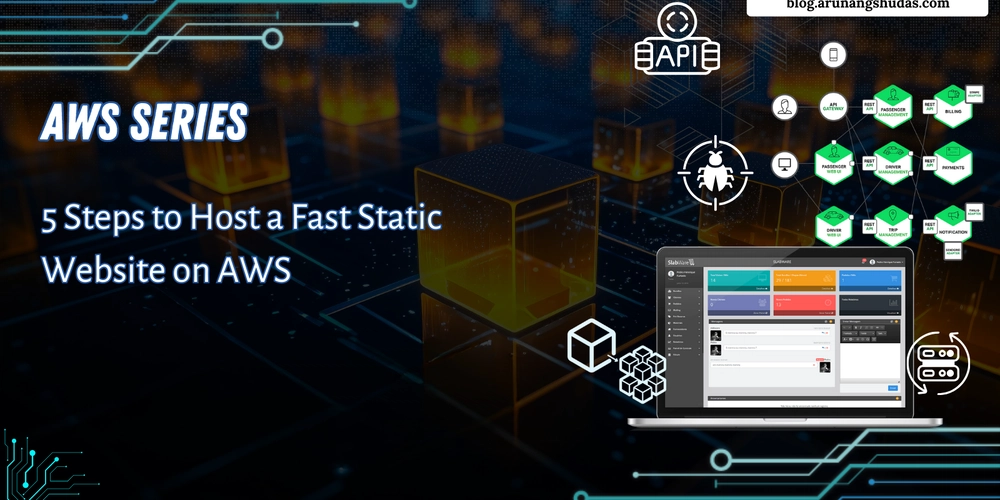Case Study: Building a Scalable CRUD Application with Quarkus
1. Overview This case study explores the development of a Person Management System using Quarkus, a Kubernetes-native Java framework optimized for cloud environments. The application demonstrates CRUD operations (Create, Read, Update, Delete) with a MySQL database, leveraging Quarkus' efficiency, developer-friendly tooling, and native compilation capabilities. 2. Project Objectives Build a performant REST API for managing Person entities. Utilize Quarkus' live coding features for rapid development. Demonstrate integration with Hibernate ORM/Panache for simplified database interactions. Package the application as a lightweight JAR and native executable. 3. Technical Architecture Architecture Diagram Key Components: MySQL Database: Stores Person records. Hibernate ORM/Panache: Manages persistence layer with active record pattern. RESTEasy: Implements JAX-RS endpoints. SmallRye OpenAPI: Auto-generates OpenAPI documentation. 4. Implementation Highlights 4.1 Data Model @Entity @Table(name = "Person") public class Person { @Id @GeneratedValue(strategy = GenerationType.IDENTITY) private Long id; private String name; // Getters/Setters } Uses Hibernate annotations for ORM mapping with MySQL auto-increment IDs. 4.2 Repository Layer @ApplicationScoped public class PersonRepository implements PanacheRepository { Person findByName(String name) { return find("name", name).firstResult(); } } Extends PanacheRepository for out-of-the-box CRUD methods while adding custom queries. 4.3 REST Service @Path("/persons") @ApplicationScoped public class PersonService { @Inject PersonRepository personRepository; @GET public Response getAllPersons() { return Response.ok(personRepository.listAll()).build(); } @POST @Transactional public Response savePerson(Person person) { personRepository.persist(person); return Response.ok(person.getName() + " saved").build(); } // PUT, DELETE methods omitted for brevity } Key Features: Transaction management via @Transactional JAX-RS annotations for endpoint definition JSON serialization/deserialization handled automatically 4.4 Database Configuration application.properties: quarkus.datasource.db-kind=mysql quarkus.datasource.jdbc.url=jdbc:mysql://localhost:3306/mydb quarkus.hibernate-orm.database.generation=update Configures MySQL connection and automatic schema updates. 5. Development Workflow 5.1 Live Coding ./mvnw clean compile quarkus:dev Code changes reflected instantly without restart Access Dev UI at http://localhost:8080/q/dev 5.2 Testing Endpoints # Create Person curl -X POST -H "Content-Type: application/json" \ -d '{"name":"John Doe"}' http://localhost:8080/persons # Retrieve All curl http://localhost:8080/persons 5.3 Packaging # Standard JAR ./mvnw package # Native Executable (GraalVM) ./mvnw package -Dnative Result: Uber-JAR size: ~15MB Native executable startup time: ~0.01s 6. Challenges & Solutions Challenge Quarkus Solution Database schema management quarkus.hibernate-orm.database.generation=update Boilerplate CRUD code PanacheRepository base class Native compilation issues Containerized builds via -Dquarkus.native.container-build=true 7. Results & Metrics API Response Times (10k requests): JVM Mode: Avg 12ms Native Mode: Avg 8ms Memory Usage: JVM Heap: ~120MB Native: ~45MB RSS 8. Conclusion This project demonstrates Quarkus' strengths in building modern Java applications: Developer Productivity: Live reload, Dev UI, and simplified Hibernate configuration. Performance: Subsecond startup times and low memory footprint in native mode. Cloud Readiness: Container-friendly packaging and native Kubernetes integration. Future Enhancements: Add frontend with Quarkus Qute templating Implement reactive endpoints with Mutiny Quarkus Documentation: quarkus.io/guides This case study demonstrates how Quarkus enables developers to build cloud-native applications that combine traditional Java strengths with modern runtime efficiencies.

1. Overview
This case study explores the development of a Person Management System using Quarkus, a Kubernetes-native Java framework optimized for cloud environments. The application demonstrates CRUD operations (Create, Read, Update, Delete) with a MySQL database, leveraging Quarkus' efficiency, developer-friendly tooling, and native compilation capabilities.
2. Project Objectives
- Build a performant REST API for managing Person entities.
- Utilize Quarkus' live coding features for rapid development.
- Demonstrate integration with Hibernate ORM/Panache for simplified database interactions.
- Package the application as a lightweight JAR and native executable.
3. Technical Architecture
Architecture Diagram
Key Components:
-
MySQL Database: Stores
Personrecords. - Hibernate ORM/Panache: Manages persistence layer with active record pattern.
- RESTEasy: Implements JAX-RS endpoints.
- SmallRye OpenAPI: Auto-generates OpenAPI documentation.
4. Implementation Highlights
4.1 Data Model
@Entity
@Table(name = "Person")
public class Person {
@Id
@GeneratedValue(strategy = GenerationType.IDENTITY)
private Long id;
private String name;
// Getters/Setters
}
Uses Hibernate annotations for ORM mapping with MySQL auto-increment IDs.
4.2 Repository Layer
@ApplicationScoped
public class PersonRepository implements PanacheRepository {
Person findByName(String name) {
return find("name", name).firstResult();
}
}
Extends PanacheRepository for out-of-the-box CRUD methods while adding custom queries.
4.3 REST Service
@Path("/persons")
@ApplicationScoped
public class PersonService {
@Inject PersonRepository personRepository;
@GET
public Response getAllPersons() {
return Response.ok(personRepository.listAll()).build();
}
@POST
@Transactional
public Response savePerson(Person person) {
personRepository.persist(person);
return Response.ok(person.getName() + " saved").build();
}
// PUT, DELETE methods omitted for brevity
}
Key Features:
- Transaction management via
@Transactional - JAX-RS annotations for endpoint definition
- JSON serialization/deserialization handled automatically
4.4 Database Configuration
application.properties:
quarkus.datasource.db-kind=mysql
quarkus.datasource.jdbc.url=jdbc:mysql://localhost:3306/mydb
quarkus.hibernate-orm.database.generation=update
Configures MySQL connection and automatic schema updates.
5. Development Workflow
5.1 Live Coding
./mvnw clean compile quarkus:dev
- Code changes reflected instantly without restart
- Access Dev UI at
http://localhost:8080/q/dev
5.2 Testing Endpoints
# Create Person
curl -X POST -H "Content-Type: application/json" \
-d '{"name":"John Doe"}' http://localhost:8080/persons
# Retrieve All
curl http://localhost:8080/persons
5.3 Packaging
# Standard JAR
./mvnw package
# Native Executable (GraalVM)
./mvnw package -Dnative
Result:
- Uber-JAR size: ~15MB
- Native executable startup time: ~0.01s
6. Challenges & Solutions
| Challenge | Quarkus Solution |
|---|---|
| Database schema management | quarkus.hibernate-orm.database.generation=update |
| Boilerplate CRUD code |
PanacheRepository base class |
| Native compilation issues | Containerized builds via -Dquarkus.native.container-build=true
|
7. Results & Metrics
-
API Response Times (10k requests):
- JVM Mode: Avg 12ms
- Native Mode: Avg 8ms
-
Memory Usage:
- JVM Heap: ~120MB
- Native: ~45MB RSS
8. Conclusion
This project demonstrates Quarkus' strengths in building modern Java applications:
- Developer Productivity: Live reload, Dev UI, and simplified Hibernate configuration.
- Performance: Subsecond startup times and low memory footprint in native mode.
- Cloud Readiness: Container-friendly packaging and native Kubernetes integration.
Future Enhancements:
- Add frontend with Quarkus Qute templating
- Implement reactive endpoints with Mutiny
Quarkus Documentation: quarkus.io/guides
This case study demonstrates how Quarkus enables developers to build cloud-native applications that combine traditional Java strengths with modern runtime efficiencies.









































































































































































![[The AI Show Episode 143]: ChatGPT Revenue Surge, New AGI Timelines, Amazon’s AI Agent, Claude for Education, Model Context Protocol & LLMs Pass the Turing Test](https://www.marketingaiinstitute.com/hubfs/ep%20143%20cover.png)


















































































































![[Tutorial] Chapter 9: Task Dashboard: Charts](https://media2.dev.to/dynamic/image/width=800%2Cheight=%2Cfit=scale-down%2Cgravity=auto%2Cformat=auto/https%3A%2F%2Fdev-to-uploads.s3.amazonaws.com%2Fuploads%2Farticles%2Fnotu3uxqtwmann665q6r.png)
![[Tutorial] Chapter 10: Task Dashboard (Part 2) - Filter & Conditions](https://media2.dev.to/dynamic/image/width=800%2Cheight=%2Cfit=scale-down%2Cgravity=auto%2Cformat=auto/https%3A%2F%2Fdev-to-uploads.s3.amazonaws.com%2Fuploads%2Farticles%2Ffjbdyeaw51nx8g13ag12.png)












![From drop-out to software architect with Jason Lengstorf [Podcast #167]](https://cdn.hashnode.com/res/hashnode/image/upload/v1743796461357/f3d19cd7-e6f5-4d7c-8bfc-eb974bc8da68.png?#)








































































































.jpg?#)
































_ArtemisDiana_Alamy.jpg?#)


 (1).webp?#)







































































-xl.jpg)













![Yes, the Gemini icon is now bigger and brighter on Android [U]](https://i0.wp.com/9to5google.com/wp-content/uploads/sites/4/2025/02/Gemini-on-Galaxy-S25.jpg?resize=1200%2C628&quality=82&strip=all&ssl=1)









![Apple Rushes Five Planes of iPhones to US Ahead of New Tariffs [Report]](https://www.iclarified.com/images/news/96967/96967/96967-640.jpg)
![Apple Vision Pro 2 Allegedly in Production Ahead of 2025 Launch [Rumor]](https://www.iclarified.com/images/news/96965/96965/96965-640.jpg)





































































































































